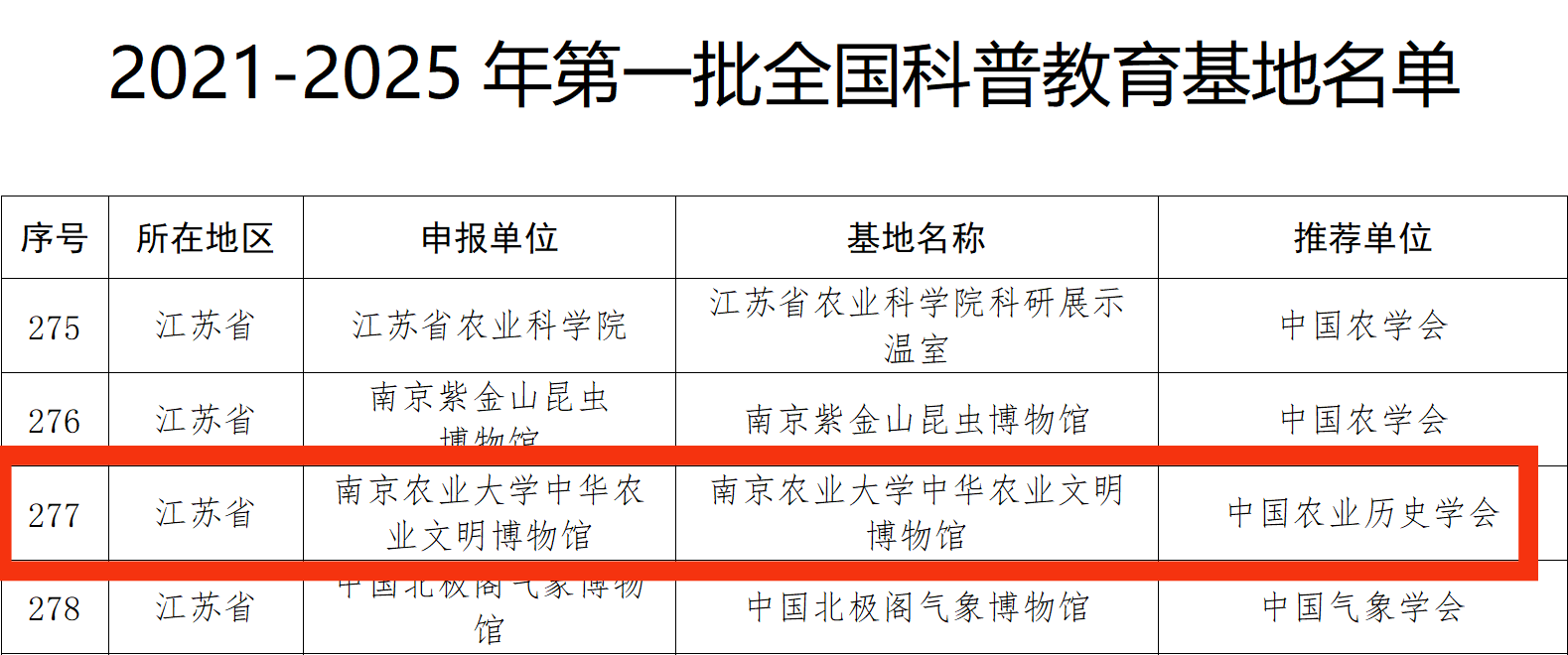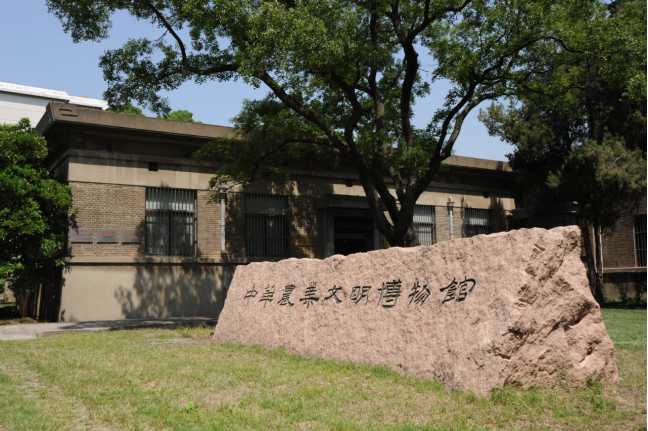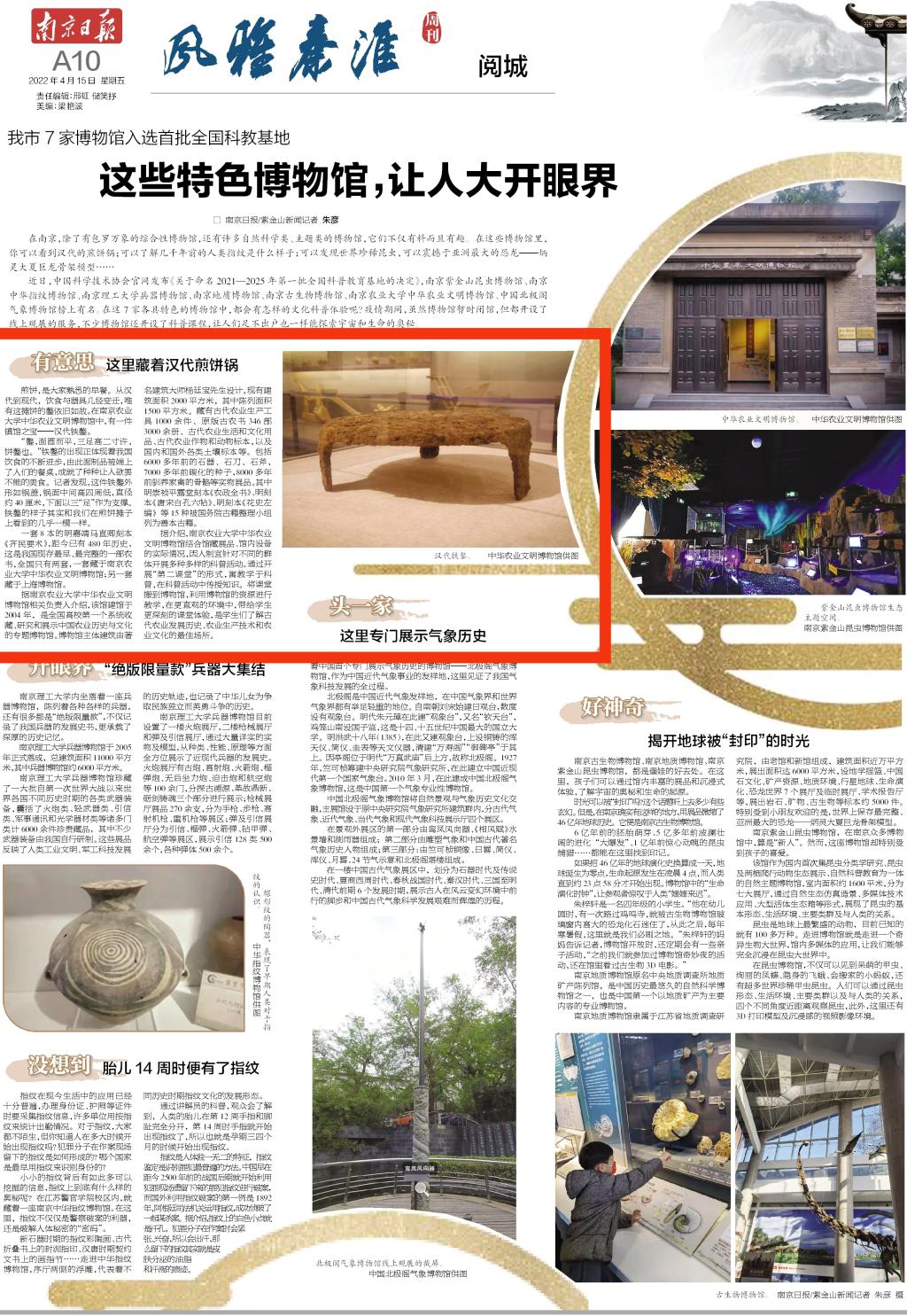The China Agricultural Civilization Museum was once again awarded the "National Science Popularization Education Base"
Release time: 2022-04-16
Article source: Agricultural Museum
Article author:
Recently, the General Office of the China Association for Science and Technology released the "Announcement on the List of the First Batch of National Popular Science Education Bases in 2021-2025", and the Chinese Agricultural Civilization Museum of Nanjing Agricultural University is listed. this honor again. On April 15, "Nanjing Daily" carried out a special report on this.

The Museum of Chinese Agricultural Civilization is located at No. 1, Nongbo Road, Nanjing Agricultural University, Xuanwu District, Nanjing City, Jiangsu Province. It was completed and opened in 2004. The museum is jointly built by Nanjing Agricultural University, Nanjing Museum and China Agricultural Museum. It is the first university-specific museum in China that systematically collects, researches and displays Chinese agricultural history and culture. Since its establishment nearly 20 years ago, the Chinese Agricultural Civilization Museum has won many awards in science exhibition, teaching practice and scientific research.

interesting! There is a Han Dynasty pancake pan hidden here
Pancakes are a familiar breakfast. From the Han Dynasty to modern times, the food and utensils have changed several times, but the cakes in this stall remain the same. In the Museum of Chinese Agricultural Civilization of Nanjing Agricultural University, there is a treasure of the town hall - the iron scorpion of the Han Dynasty. "Shou, the face is round and flat, the three feet are two inches high, and the cake is also." The appearance of the iron scorpion reflects the continuous progress of our country's diet. As a result, noodle products are brought to people's dining table, and all kinds of unstoppable achievements have been made. delicacy. The reporter found that this iron clasp looks like a pot lid, the middle of the pot is high and the sides are low, the diameter is about 40 cm, and the bottom is supported by three "feet". The iron shovel is actually almost exactly the same as what we saw at the pancake stand.
A set of 8 sets of Ming Jiajing Ma Zhiqing's block-printed "Qi Min Yao Shu" has a history of 480 years. This is the earliest and most complete agricultural book in our country. There are only two sets in the country. One set is hidden in Nanjing Agricultural University. The Museum of Chinese Agricultural Civilization and the other set are in the Shanghai Museum.
According to the relevant person in charge of the Chinese Agricultural Civilization Museum of Nanjing Agricultural University, the museum was established in 2004. It is the first special museum for systematic collection, research and display of Chinese agricultural history and culture in universities across the country. The main building of the museum is designed by the famous architect Mr. Yang Tingbao. The existing building area is 2000 square meters, of which the exhibition area is 1500 square meters. There are more than 1,000 ancient agricultural production tools, more than 3,000 volumes of 346 original ancient agricultural books, ancient agricultural life and cultural supplies, ancient agricultural crops and animal specimens, as well as various domestic and foreign soil specimens. Including stone tools, stone knives, stone axes more than 6,000 years ago, carbonized seeds more than 7,000 years ago, bones of domesticated poultry more than 8,000 years ago and other physical exhibits. Among them, 15 kinds of ancient books, including the Ming Chongzhen Pinglutang block-printed "Agricultural Zhengquan Shu", the Ming block-printed "Bai Kong Liu Tie of the Tang and Song Dynasties", and the Ming block-printed "Hua Shi Zuobian", were listed as rare ancient books by the ancient book sorting group of the State Council.
According to reports, the Chinese Agricultural Civilization Museum of Nanjing Agricultural University has carried out a variety of popular science activities for different groups based on the actual situation of the exhibits and equipment in the museum. By carrying out the form of "Second Classroom", teaching is integrated into popular science, and knowledge is imparted in popular science activities. Moving the classroom to the museum, using the resources of the museum for teaching, brings students a more profound classroom experience in a more intuitive environment, and is the best place for students to understand the history of ancient agricultural development, agricultural production technology and agricultural culture.
